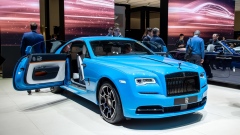Apr 5, 2021
The New Jeep Wrangler Rubicon 392 Is Like Old Faithful on Viagra
, Bloomberg News
(Bloomberg) -- The 2021 Jeep Wrangler Rubicon 392 is expensive. With a starting price of $74,995 including destination charges, it costs as much as the most expensive variants of Land Rover’s new Defender. That’s $46,000 more than the price of a base Wrangler.
The Wrangler Rubicon 392 is loud. Speeding down a long two-lane highway near Moab, Utah, on March 30, it barked and belched like an angry junkyard pit bull. It reached 60 mph in 4.5 seconds, nearly a second faster than a Jaguar F-Type sports car.
The Wrangler Rubicon 392 is large. At 5,103 pounds, nearly 10 feet long at the wheelbase, and two inches higher than a standard Wrangler, its hulk downright overshadows the nimble motorized sprites that can scamper up boulders in the most remote environs.
In short: Jeep’s new star is the exact opposite of what Elon Musk, Porsche, Audi, and half of China are trying to do with electric power and fuel efficiency. (EPA fuel economy ratings for the Rubicon 392 are 14 mpg in combined city and highway driving.) And with gold badging all over its body and that unmistakable round-headlight, long-toothed Jeep grille, it doesn’t feel bad about any of it.
As I turned off the highway onto the dusty paths that would lead me to trails rated for “experienced” drivers only in a place called, rather obviously, Behind the Rocks, I thought about how the 392 is the perfect rig for Jeep to bring to market now. It will be the foil to the electric contingent, giving passionate off-grid wanderers and heavy-duty weekend warriors a durable, domineering workhorse with tried-and-true reliability and true trail-ready toughness right off the factory floor.
With Jeep sales in the U.S. already up significantly more in the past six months than ever before, according to Jeep Vice President Jim Morrison, and with ample upgrades and customizations that lend it a fat margin (virtually 100% of the 392 will be customized before and aftermarket, Morrison says), this unapologetic Mopar monster is destined to be a smash hit.
Big-Boned Ballerina
The first Wrangler in 40 years to pack a V-8 engine under its air-scooped hood, the Rubicon 392 is the fastest and most powerful Wrangler ever—with 470 horsepower and 470 pound-feet of torque, it is three times as powerful as the last Wrangler to carry a V-8 and 40% faster than the modern Wrangler Rubicons that carry a V-6 engine.
But its speed becomes less important the more time you spend off-road, where technical prowess matters. Here its eight-speed automatic transmission is the most urgent essential, delivering quick, crisp gear changes and ratios that afford the right response at the right time.
During my time driving the Wrangler Rubicon 392, I tested it through all four of its selectable gearing modes—4WD Auto, 4WD High, Neutral (normal), and 4WD Low. Led by Nina Barlow, Jeep’s approved tour guide for the day, I canvassed sun-bleached boulders the size of ’70s-style TVs, shale-covered washes, acres of Mars-red sand, and seemingly endless trails of limestone and granite.
I am far from an expert off-roader, though I have driven off-road many times over the years in the course of my reporting. Still I found the drive modes and the two-speed transfer case (the system that allows for lower gear ratios when crawling over steep terrain) to be push-button intuitive—literally. One press of the appropriate button on the dashboard maintained power in all wheels so effectively that the 392 pirouetted down trails usually only accessible by the spider-like contraptions with metal cage bodies and giant knobby wheels that serious off-roaders build at home. It was like a scene from Mad Max, plus Jeep. I didn’t see another OEM stock vehicle out there all day.
During my drive I also tested “Off-Road Plus,” another setting with rock and sand modes, which adjust throttle, transmission shift points, and traction control for peak performance on higher-speed passes on loose terrain. There was something liberating about flying over ruddy sand as fine as powder, far away from work deadlines, family concerns, coronavirus restrictions, and state troopers monitoring traffic infractions.
That the Off-road Plus drive mode let me lock the rear axle and fly is notable because, as Jeep brass tell me, it’s that specific capability which is the primary practical benefit of the V-8 architecture over the less-expensive V-6—cool new engine note and obvious bragging rights notwithstanding.
New Treats Now Standard
The Rubicon 392 offers lots of other trail functions to smooth power delivery, adjust gear ratios, lock and unlock differentials, and disconnect the front sway bar, for instance. In the very legit, tougher-than-us-all overlanders of yore these might have been complicated, but here modern convenience allows for buttons and levers that are easily adjusted in the roomy Rubicon cabin.
For the most fervent Jeep lovers, there’s improved ground clearance and suspension; improved approach and departure angles; and improved fording capability, should the need to cross a minor river arise. (For me under the blazing Canyonlands sun, it didn’t.)
There are some new things to play with, like lightweight half-doors (no top nor frame) that make entry and exit so easy it felt like I could practically jump through the door into the vehicle. Leather-covered seats and a hardtop roof (preferred over canvas for those of us who like a quiet cabin) are premium features now standard. A new sport steering wheel with shift paddles is, too, although I wish the paddles had either been longer or not affixed to the steering wheel itself—during quick maneuvering in manual mode I frequently found myself going to shift and instead grabbing air.
Rear and storage space in the Rubicon 392 remains the same as that of its less-powerful brethren: 41 inches of headroom (enough to airily fit my large-brim fedora hat and me); 62 inches of knee clearance in the back (very important for those of us with boney, sensitive knees); and 67.4 cubic inches of cargo room with the rear seats folded. Airy, indeed.
Old Faithful Ain’t All Bad
I drove into the desert with the 392 expecting it to feel like a relic from another time—a 6.4-liter V-8 engine is dinosaur technology compared to what some companies are doing with battery power, including Jeep (watch this space for more on the electric Grand Wagoneer and electric Wrangler).
But I came away with a sense of freedom. Idling in the hotel parking lot after I had returned to town, the 392 felt alive, potent with the potential for adventure and a proven ability to go anywhere I had the courage to send it.
I eagerly anticipate the electric Wrangler and Tesla’s and Rivian’s electric trucks as much as the next person. But with the exception of Rivian’s promised R1T in June, they remain conceptual at best—untried in every way. For the here and now, the Wrangler Rubicon 392 is like Old Faithful with a big V-8 shot of sex appeal. No apologies needed.
©2021 Bloomberg L.P.


